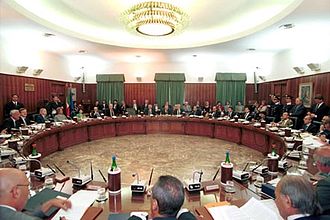Consiglio Superiore della Magistratura
The Consiglio Superiore della Magistratura ( CSM ) is Italy's “Supreme Council of Justice”. The CSM is the self-governing body of Italian judges and prosecutors working in the ordinary judiciary .
The official seat of the CSM is in the Palazzo dei Marescialli on the Piazza dell'Indipendenza in Rome .
occupation
The council consists of 24 elected members (two-thirds elected by the judiciary, one-third by parliament in joint session) and three members by law: the President of the Republic , the President of the Court of Cassation and the Procurator General at the Court of Cassation.
The chairman is de jure the Italian President . The members of the CSM elect a deputy chairman from among their number, who takes over the chairmanship of the meetings and the official business, if the President does not do so.
Organization and responsibilities
The Italian Ministry of Justice only takes on organizational tasks in the area of ordinary justice. Judges and prosecutors are not subordinate to the Ministry of Justice, but to their self-governing body, the CSM. In the exercise of their office, judges are independent, the executive has no right to give instructions to the public prosecutor. The judges and public prosecutors of the administrative , financial and military jurisdiction have their own self-governing bodies, which are organized along the lines of the CSM.
In particular, the CSM is responsible for the selection and recruitment of judges and public prosecutors of the ordinary courts as well as for their transfer and promotion. He can also take disciplinary action. The work of the CSM takes place in plenary sessions or in eight specialist committees , a budget commission and a disciplinary section. The CSM is supported by subordinate judicial councils in the appellate courts . For the training of judges and public prosecutors, the CSM and the Ministry of Justice maintain the Scuola superiore della magistratura .
history
After the unification of Italy in 1861, judges and prosecutors were only formally independent from the government. In 1880 a commission was set up at the Ministry of Justice, which consisted of four judges and a public prosecutor from the Court of Cassation in Rome and advised the Minister of Justice on pending promotions and transfers of judges and public prosecutors. By law of July 14, 1907, the Consiglio Superiore della Magistratura was established as an advisory body. Half of its members were initially elected by the highest judges and prosecutors, while the rest were appointed by the government. However, from 1912 to 1921 and from 1923 to 1946 the government appointed all members of the CSM.
With the end of fascism , the abolition of the monarchy and the new republican constitution of 1948, the basis for the CSM in its current form was created. Originally, the Constituent Assembly planned that all members would be elected by judges and prosecutors only. In order to counteract a complete independence, it was finally decided to have a third of the members elected by parliament. Since the decisions about the tasks and composition of the CSM were very controversial, there was considerable resistance and delays in the implementation of the constitutional requirements. The law establishing the CSM as a self-governing body did not come into force until 1958. Since it did not correspond in all respects to the original intentions of the constitutional fathers and even an attempt had been made to undermine self-governing powers, the constitutional court repealed parts of the law in 1963. In 1967 the law was finally amended, giving the CSM a solid working basis.
Field Office
The Palazzo dei Marescialli was built in 1937 and 1938 on the northeast corner of the Piazza dell'Indipendenza as an office and officers' mess for the Marshals of Italy . At that time, the rooms on the ground floor were used for meetings, events and seminars as well as a reading room, while the marshals' offices were located in the piano nobile . A statue of Julius Caesar was placed in the courtyard . The building remained orphaned after World War II until the CSM moved in on February 15, 1962.
The German embassy is around 50 meters north .
See also
Web links
- Official website (Italian)
Coordinates: 41 ° 54 ′ 16.7 " N , 12 ° 30 ′ 12.4" E
